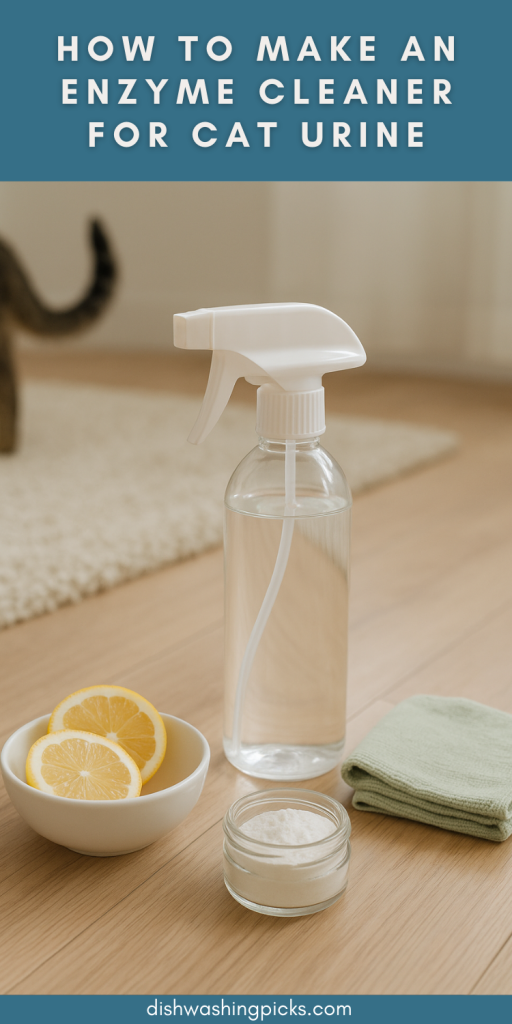
The Struggle is Real
If you’ve ever lived with a cat, you know two things: one, they run the house, and two, when accidents happen, they don’t exactly smell like roses. In fact, cat urine has this way of announcing itself the moment you walk through the door—like, “Hi, I was here before you even put down your keys.”
Sure, you could grab a bottle of store-bought cleaner, but those can be pricey and full of mystery ingredients you can’t even pronounce. The good news? You can actually whip up your own enzyme cleaner at home. And it’s not as intimidating as it sounds. Ready to outsmart your cat’s accidents? Let’s dig in.
Why Enzyme Cleaner? (And Why Regular Cleaners Don’t Cut It)
Here’s the thing about cat urine—it’s not just about the smell. The odor comes from uric acid crystals, which don’t budge with plain soap and water. You can mop, scrub, spray perfume… but your cat’s super-nose will still pick it up.
That’s where enzymes come in. They’re like little microscopic Pac-Men, chomping away at the uric acid until there’s literally nothing left for your cat to sniff out. No lingering smell, no “hey, this is my bathroom now” signals. Just a clean slate.
So yeah, enzymes are the real MVPs here. And yes—you can make them at home.
What You’ll Need (Nothing Fancy, Promise)
To make your own enzyme cleaner, you’ll need just a handful of kitchen staples and a little patience:
- Citrus peels (lemon, orange, lime—take your pick)
- Brown sugar
- Water
- A plastic bottle with a tight cap (think soda bottle)
- A little time (spoiler: this isn’t instant, but it’s worth it)
That’s it. No lab equipment, no expensive ingredients. Just stuff you’d probably throw out otherwise.
The Recipe: Brewing Up Your Cleaner
Okay, here’s where the magic happens. Think of this as a slow-cooked recipe for your house.
- Add ingredients to the bottle
- 2 cups of citrus peels
- ½ cup brown sugar
- 4 cups water
- 2 cups of citrus peels
- Seal and shake
Give it a good shake until the sugar dissolves. - Ferment
Leave the bottle in a warm spot for about 3 months. Yep, months. During this time, natural enzymes form as the citrus breaks down. - Burp the bottle
Once a day for the first couple of weeks, loosen the cap slightly to release gas (like burping a baby, but way less messy). - Strain and store
After fermentation, strain out the solids and pour the liquid into a spray bottle. Congrats—you’ve got homemade enzyme cleaner!
How to Use Your Enzyme Cleaner
Now that you’ve got your secret weapon, here’s how to put it to work:
- Blot first – If the urine is fresh, blot as much as possible with paper towels.
- Spray generously – Soak the area with your enzyme cleaner.
- Let it sit – Give it at least 10–15 minutes to work its magic. For carpets, longer is better.
- Blot again – Dab up the excess liquid and let the area air dry.
Imagine it like giving your carpet or couch a detox. You want the enzymes to fully break down the stink-causing stuff, not just mask it.
Extra Tips for Best Results
- Patience is key. The homemade version takes time to ferment, so plan ahead.
- Label the bottle. You don’t want anyone mistaking it for iced tea.
- Test first. Try it on a small spot to make sure it doesn’t discolor fabrics.
- Make a batch in advance. Once ready, it lasts for months in a cool place.
Wrapping It Up
So there you have it—your very own homemade enzyme cleaner for cat urine. It’s budget-friendly, eco-friendly, and honestly, kind of satisfying to make. Sure, it takes a little patience, but once you’ve got a bottle on hand, you’ll never have to panic about cat “accidents” again.
Next time your furry overlord decides your carpet is the litter box, you’ll be ready. No more nose-wrinkling, no more endless scrubbing—just a fresh, clean home.
Because let’s face it: you may not win every battle with your cat, but with this cleaner, at least you win the war on smells.
